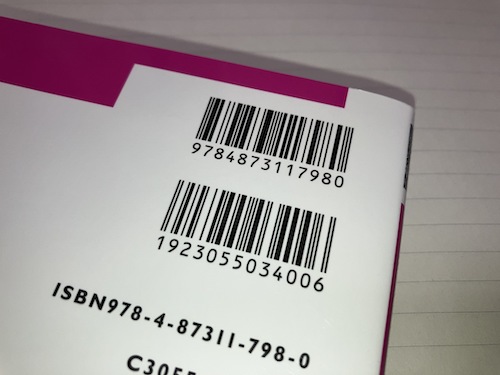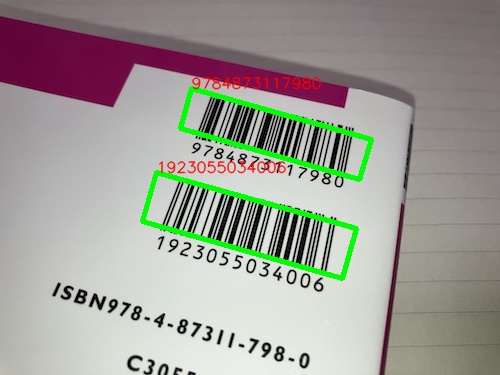Detect and read barcodes with OpenCV in Python
This article describes how to detect and read barcodes with OpenCV in Python.
cv2.barcodeis included in the OpenCV contrib module- Super Resolution Model
- Detect and read barcodes from an image
- Detect and read barcodes from camera video
See the following article on how to detect and read QR codes instead of barcodes.
You can also use ZBar (pyzbar). Although not thoroughly verified, ZBar seems to have better detection accuracy.
The version of OpenCV used in the sample code is 4.6.0.
import cv2
print(cv2.__version__)
# 4.6.0
cv2.barcode is included in the OpenCV contrib module
The cv2.barcode to detect and read barcodes is included in the contrib module (as of version 4.6.0).
In the output of cv2.getBuildInformation(), barcode must be included in To be built of OpenCV modules.
For example, on macOS, if you installed OpenCV with Homebrew, the contrib module should be included, but if you installed opencv-python with pip, it might not be included. You need to install OpenCV with pip install opencv-contrib-python.
Super Resolution Model
The official tutorial introduces the Super Resolution Model.
You can download and use sr.prototxt, sr.caffemodel from the following repository.
Specify the path of the downloaded file to cv2.barcode.BarcodeDetector(). If omitted, no model is used.
bd = cv2.barcode.BarcodeDetector('/path/to/sr.prototxt', '/path/to/sr.caffemodel')
I may be doing something wrong, but I did not notice any difference in accuracy with or without the model in my environment. It is not used in the sample code below.
Detect and read barcodes from an image
The following barcode image is used as an example.
img = cv2.imread('data/src/barcode.jpg')

Create an instance of cv2.barcode.BarcodeDetector and execute detectAndDecode(). Although detect() to only detect and decode() to decode based on the detected coordinates are also provided, they are not mentioned here.
Note that the results may differ depending on the version and environment.
bd = cv2.barcode.BarcodeDetector()
# bd = cv2.barcode.BarcodeDetector('path/to/sr.prototxt', 'path/to/sr.caffemodel')
retval, decoded_info, decoded_type, points = bd.detectAndDecode(img)
retval is True if a barcode is detected and False if none is detected.
print(retval)
# True
decoded_info is a tuple whose elements are strings stored in barcodes. If it can be detected but not decoded, it is an empty string ''.
print(decoded_info)
# ('1923055034006', '9784873117980')
decoded_type is a tuple whose elements are numbers representing barcode types.
print(decoded_type)
# (2, 2)
print(cv2.barcode.EAN_13)
# 2
points is a numpy.ndarray representing the coordinates of the four corners of the detected QR Code.
print(type(points))
# <class 'numpy.ndarray'>
print(points)
# [[[142.38849 221.83641]
# [156.36218 172.35411]
# [356.90564 228.98714]
# [342.93195 278.46942]]
#
# [[180.30583 128.89304]
# [191.59013 88.83808]
# [371.00458 139.38284]
# [359.72028 179.4378 ]]]
print(points.shape)
# (2, 4, 2)
Draw frames for the detected barcode and superimpose the decoded text.
img = cv2.polylines(img, points.astype(int), True, (0, 255, 0), 3)
for s, p in zip(decoded_info, points):
img = cv2.putText(img, s, p[1].astype(int),
cv2.FONT_HERSHEY_SIMPLEX, 0.5, (0, 0, 255), 1, cv2.LINE_AA)
cv2.imwrite('data/dst/barcode_opencv.jpg', img)

Detect and read barcodes from camera video
The following is a sample code that detects and reads barcodes from real-time camera video.
See the following article for more information on the handling of videos in OpenCV.
Press q on the keyboard to exit.
import cv2
camera_id = 0
delay = 1
window_name = 'OpenCV Barcode'
bd = cv2.barcode.BarcodeDetector()
cap = cv2.VideoCapture(camera_id)
while True:
ret, frame = cap.read()
if ret:
ret_bc, decoded_info, _, points = bd.detectAndDecode(frame)
if ret_bc:
frame = cv2.polylines(frame, points.astype(int), True, (0, 255, 0), 3)
for s, p in zip(decoded_info, points):
if s:
print(s)
frame = cv2.putText(frame, s, p[1].astype(int),
cv2.FONT_HERSHEY_SIMPLEX, 2, (0, 0, 255), 2, cv2.LINE_AA)
cv2.imshow(window_name, frame)
if cv2.waitKey(delay) & 0xFF == ord('q'):
break
cv2.destroyWindow(window_name)
In an actual application, the while loop would be terminated by break when the decoded_info string is obtained, and the application would move on to operation using the string.